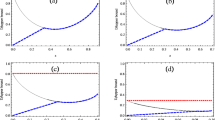We examine the possible states of subsystems of a system of bits or qubits. In the classical case (bits), this means the possible marginal distributions of a probability distribution on a finite number of binary variables; we give necessary and sufficient conditions for a set of probability distributions on all proper subsets of the variables to be the marginals of a single distribution on the full set. In the quantum case (qubits), we consider mixed states of subsets of a set of qubits; in the case of three qubits we find quantum Bell inequalities—necessary conditions for a set of two-qubit states to be the reduced states of a mixed state of three qubits. We conjecture that these conditions are also sufficient.
Similar content being viewed by others
References
Wigner E.P. (1970). “On hidden variables and quantum mechanical probabilities”. Am. J. Phys. 38:1005
Peres A. (1999). “All the Bell inequalities”. Found. Phys. 29:589 quant-ph/9807017
Hall W. (2005). “Multipartite reduction criteria”. Phys. Rev. A 72:022311
Boole G. Investigation of the Laws of Thought (1858) (Dover, New York, 1951).
Pitowsky I. (1986). “The range of quantum probability”. J. Math. Phys. 27:1556
Pitowsky I. (1989). Quantum Probability – Quantum Logic. Springer, Berlin
Pitowsky I. (1991). “Correlation polytopes: their geometry and complexity”. Math. Program. 50:395
Kolmogorov A.N. (1950). Foundations of Probability Theory. Chelsea, London
Parthasarathy K.R. (2005). “Extremal quantum states in coupled systems”. Ann. Inst. H. Poincare – Prob. Stat. 41:257
Rudolph O. (2004). “On extremal quantum states of composite systems with fixed marginals”. J. Math. Phys. 45:4035 quant-ph/0406021
Higuchi A., Sudbery A., and Szulc J. (2003). “One-qubit reduced states of a pure many-qubit state: polygon inequalities”. Phys. Rev. Lett. 90:107902 quant-ph/0209085
Higuchi A., “On the one-particle reduced density matrices of a pure three-qutrit quantum state,” J. Math. Phys. to appear. quant-ph/0309186
Bravyi S. (2004). “Requirements for compatibility between local and multipartite quantum states”. Quantum Inf. Comp. 4:12 quant-ph/0301014
Y.-Han J., Y.-Zhang S., and G.-C. Guo, “Compatibility relations between the reduced and global density matrices,” quant-ph/0403151
Jones N.S., and Linden N. (2005). “Parts of quantum states”. Phys. Rev. A 71:012324 quant-ph/0407117
Diósi L. (2004). “Three-party pure quantum states are determined by two two-party reduced states”. Phys. Rev. A 70:10302 quant-ph/0403200
Linden N., Popescu S., and Wootters W.K. (2002). “Almost every pure state of three qubits is completely determined by its two-particle reduced density matrices”. Phys. Rev. Lett. 89:207901 quant-ph/0207109
Coleman A.J., and Yukalov V.I. (2000). Reduced Density Matrices: Coulson’s Challenge. Springer, Berlin
Cerf N.J., Adami C., and Gingrich R.M. (1999). “Quantum conditional operator and a criterion for separability”. Phys. Rev. A 60:893 quant-ph/9710001
Horodecki M. and Horodecki P. (1999). “Reduction criterion of separability and limits for a class of protocols of entanglement distillation”. Phys. Rev. A 59:4206 quant-ph/9708015
Klyachko A., “Quantum marginal problem and representations of the symmetric group,” quant-ph/0409113
Daftuar S. and Hayden P. (2005). “Quantum state transformations and the Schubert calculus”. Ann. Phys. 315:80
Christandl M. and Mitchison G. (2006). “The spectra of density operators and the Kronecker coefficients of the symmetric group”. Commun. Math. Phys. 261:789
Coleman A.J. (1963). “Structure of fermion density matrices”. Rev. Mod. Phys. 35:668
Klyachko A., “Quantum marginal problem and N-representability” quant-ph/0511102
Author information
Authors and Affiliations
Corresponding author
Rights and permissions
About this article
Cite this article
Butterley, P., Sudbery, A. & Szulc, J. Compatibility of Subsystem States. Found Phys 36, 83–101 (2006). https://doi.org/10.1007/s10701-005-9006-z
Received:
Published:
Issue Date:
DOI: https://doi.org/10.1007/s10701-005-9006-z




